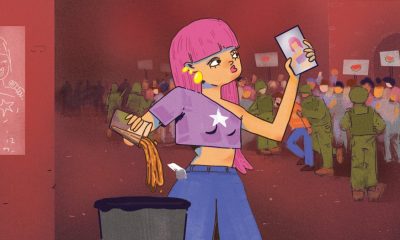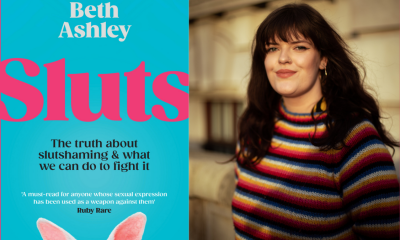Technology
Why the original ‘Texas Chainsaw Massacre’ beats any remake

Welcome to Thanks, I Love It, our series highlighting something onscreen we’re obsessed with this week.
At the risk of pissing off every gore-loving Saw franchise fanatic or Human Centipede devotee (if you sick freaks even exist), we need to state an undeniable truth: After all these decades, the original Texas Chainsaw Massacre still reigns supreme as the ultimate masterclass in gross body horror.
Back in 1974, the beloved slasher was unlike anything audiences had ever seen before. Receiving an X rating in America, it was flat-out banned from several countries, including the UK. Yet despite featuring literal cannibals hungry for innocent teen flesh, the first Texas Chainsaw Massacre was surprisingly devoid of any truly graphic gore. In fact, director Tobe Hooper purposefully shot his first feature film with a PG rating in mind, only for an obviously shook MPAA to slap him with its most explicit label available at the time (later replaced by today’s NC-17).
After the first film’s unmitigated success, Hooper got a free license to amp up the bloodiness as many notches as he wanted in the sequels. But that only resulted in films with 100% more camp and about 15% of its predecessor’s masterfully immersive rancidness. Every subsequent reboot, like the 2003 series (and, in all likelihood, the upcoming 2022 remake) equally fails to capture the original’s iconically understated grisliness.
I don’t know if we’ll ever get another horror movie where you can so viscerally smell the blood, sweat, and decay wafting off the silver screen.
I don’t know if we’ll ever get another horror movie where you can so viscerally smell the blood, sweat, and decay wafting off the silver screen. Much like the happy accident that forced Steven Spielberg to barely show the titular shark in Jaws, 1974’s Texas Chainsaw Massacre‘s PG-restrictiveness inadvertently revealed how less can be so much more when it comes to body horror. Over-the-top torture porn certainly makes one squeamish. But The Texas Chainsaw Massacre grounds viewers in a body horror that’s closer to home — and far more disturbing for it.
In one of Hooper’s most famous quotes on horror, the director insists, “You’ve got to send a physical sensation through and not let [the audience] off the hook.” And let us off the hook he does not! Hooper’s Leatherface instead casually hangs us on a meat hook by our flesh, only to ignore our screams and meander off to deal with something more pressing.
In essence, The Texas Chainsaw Massacre reveals the stark difference between horror that prioritizes grossness over goriness. In the modern age of gore horror, popularized by franchises like Saw, the fantastically over-the-top torture of a character scooping out their own eyeball has an almost disassociative effect, numbing the viewer with shock value. In contrast, Texas Chainsaw Massacre keeps you trapped in a mundane, existential disgust over just how fragile the human body you’re living in really is.

Leatherface got all dressed up for his dinner date 🙂
Credit: Vortex
Despite the bombastic flashiness of Leatherface’s iconic weapon, his most horrific kills are carried out with the quick and quiet precision of a club. A single crack to the skull of Pam’s boyfriend, Kirk, sends the poor hunk into a silent seizure reminiscent of a floundering fish out of water. It’s the kind of body horror that shows how brutally easy it is to turn us all into lifeless meat sacks, rather than reveling in how much drawn-out mutilation a person can handle before expiring.
The terror of The Texas Chainsaw Massacre lies in each character being so unceremoniously dealt with — like they’re just livestock at a slaughterhouse. There’s no particular cruelty or belabored torment to Leatherface’s matter-of-fact executions. Each death is over in the span of about a five-second shot, each kill performed with the practiced professionalism of a man who’s been doing this so long he barely notices when the last gasps for air leave your body so he can finally just be done with the job already. In his longer standoffs with Sally, the physical altercations are almost comically awkward. Her panicked desperation is met with little more than mild annoyance that this little lamb won’t accept her inevitable fate of winding up skewered on his family’s dinner table.
“Texas Chainsaw Massacre” keeps you trapped in a mundane, existential disgust over just how fragile the human body you’re living in really is.
Modern horror can take a lot of lessons from the cinematic choices of this undisputed classic. Yet, at the same time, as we learn more about real-life horror stories the cast had to go through to get that realism, it raises some important ethical questions. According to many cast and crew members, shoots often lasted as many as 16 hours and took place during an awful heatwave in Texas. Allegedly, during the shooting of the iconic dinner scene, real animal corpses were used as props. They filled the unventilated set with such a putrid stench of rot that people had to go outside to puke, only to jump right back into the scene.
I love the pungent, embodied fear that permeates every showing of this movie. But if we’re going to re-evaluate Stanley Kubrick’s abusive workplace behavior during The Shining, then we should certainly afford Tobe Hooper the same scrutiny. We likely won’t get another horror masterpiece quite like 1974’s Texas Chainsaw Massacre ever again. And honestly, maybe we shouldn’t.
The Texas Chainsaw Massacre (1979) is now streaming on Prime Video.
-

 Entertainment5 days ago
Entertainment5 days agoiPad Pro 2024 now has OLED: 5 reasons this is a big deal
-

 Business7 days ago
Business7 days agoThe Rabbit r1 shipped half-baked, but that’s kind of the point
-

 Entertainment6 days ago
Entertainment6 days agoWhy should we care what celebrities like Taylor Swift and Billie Eilish say about Palestine?
-

 Entertainment5 days ago
Entertainment5 days ago‘Stardew Valley’ has an official cookbook. Here’s how to make Seafoam Pudding.
-

 Business5 days ago
Business5 days agoLegion’s founder aims to close the gap between what employers and workers need
-

 Business4 days ago
Business4 days agoCheckfirst raises $1.5M pre-seed, applying AI to remote inspections and audits
-

 Entertainment4 days ago
Entertainment4 days agoSlutshaming on the internet: Read an extract from ‘Sluts’ by Beth Ashley
-

 Business4 days ago
Business4 days agoNBA champion Kyle Kuzma looks to bring his team mentality to Scrum Ventures





















